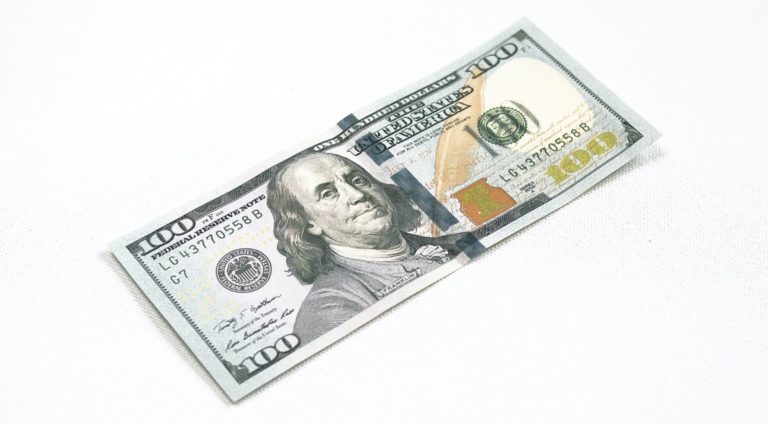
Key Points
- Millionaires save their money by paying themselves first before anything else—even before bills.
- Millionaires often save their money to then invest it so that their money is working for them.
- In this article, we’ve outlined how you can save money like a millionaire so that you can get closer to your financial goals.
If you’re looking for how to save money like a millionaire, then you’ve come to the right place.
My wife Courtney and I have mastered the art of saving money. So much so, we were able to save over $17,399 in just under 3 months.
And before that, we saved a whopping $30,000 in about 8 months! We used a good portion of that to buy our first home.
In this article, you’re going to learn how to save money like a millionaire.
1. Live way below your means
Billionaire Warren Buffett lives in a house that he bought for $31,500 in 1958 (about $250,000 in today’s dollars).
He still lives in that house today, but his net worth is about $67.7 billion. You see, Mr. Buffett has taken “live below your means” to the extreme.
He has the option to buy any house in the world. Yet, he chooses to remain in his modest home in Omaha, Nebraska.
Being wealthy is a mindset
Contrary to what many people believe, most millionaires and billionaires view money as something to invest, rather than something to spend. Warren Buffett takes this to the extreme. It’s the reason he won’t upgrade his home. However, it’s also the reason he’s one of the most wealthy individuals in the world.
He knew how to save money like a millionaire. And he still knows how to save money like a millionaire (or like a billionaire.)
How to live below your means
Living below your means starts with your spending. If a doctor earns $200,000 per year but spends $200,000 per year, then the doctor is no better off than they were the year before.
If you are earning $50,000 per year, you should not live like you are earning $50,000 per year. Instead, you should live like you earn $30,000 or $40,000 per year so that you can save the rest.
“But Joshua, there’s no way I can afford to save even $1! I’ve got bills, groceries, and my Netflix subscription that I have to pay for!”
Then you don’t want “it” bad enough.
“It” is the reason you want to save money. And if you are not willing to make sacrifices, then you aren’t motivated enough to achieve your goal. What is your goal? Do you want to:
- Buy a new car
- Put a down payment on a new home
- Buy your first rental property
- Start your new business
Whatever your reason is, that reason is your “it” and if you want it bad enough, then you have to be willing to make sacrifices. Living below your means requires focus and commitment. You have to be focused on your goal—the reason you want to save money in the first place. And you have to be committed to achieving that goal.
If you stay focused on your goal and are committed to achieving it, then making sacrifices in your daily life will be easy. Saving money becomes a game. You can’t wait to find ways to cut back your spending so that you can save more money and get closer to your goal.
Two years ago when my wife and I first started saving money for a down payment on our new home, we took a hard look at our spending and decided together what we thought was essential and what was not essential.
Another way of saying this is “wants versus needs”. I don’t know exactly what your situation looks like. So I can’t tell you exactly what you should or shouldn’t cut out of your life (such as your Netflix subscription).
However, I can give you examples of things that you might want to consider cutting to save more money. These are all nonessential things, also known as wants:
- Eating out
- Buying coffee (Starbucks, Dunkin’, etc.)
- Buying clothes (beyond the bare necessities)
- Cable
- Gym membership
- Going to the movies
- Streaming subscriptions (Netflix, Hulu, HBO, etc.)
- Magazine/newspaper subscriptions
- Unplanned purchases (random purchases here and there)
To name a few things. But this list goes on. You have to stop and ask yourself—is this really helping me get closer to my goal?
Is going shopping every weekend helping me get closer to my goal? Is having a subscription to Netflix, Hulu, and Amazon Prime helping me get closer to my goal?
“But Netflix only costs me $15 a month. That’s not a big deal!” Generally speaking, yes, a $15 Netflix subscription is pretty small in the grand scheme of things.
However, like any habit, small changes eventually translate into bigger changes. If you can get into the habit of cutting small expenses like that $2 cup of coffee and a monthly subscription, then eventually it will be easier to cut bigger expenses like vacations and shopping sprees.
These things are satisfying short-term, but they obliterate your long-term success. And if you have big dreams, then you have to start making short-term sacrifices. Here’s the secret to how to save money like a millionaire in one sentence: Successful people sacrifice short-term pleasures for long-term happiness.
You’ve heard this cliche before—life is not a sprint, it’s a marathon. To help you cut your expenses even further, in the next section I will give you a list of apps you can use to help automate the process.
Best apps for money management
Two years ago when Courtney and I saved $30,000 in about 8 months, one thing that helped us drastically was visually seeing our finances.
Before that, we never looked at our credit card statements and bank statements. Yes, we would check our credit card balance and pay it off. Yes, we would check our bank account to see how much money we had left.
But we never sat down and actually looked at our financial statements to see the nitty-gritty of what we were spending money on. Something happens when you actually look at each individual purchase. Emotions get involved.
It’s easy to swipe a piece of plastic and not feel any emotions. But when you look to see the details of your credit card statement, it makes you question your spending habits. We now use a number of apps that help us visualize our spending and overall finances.
2. Open a Roth IRA
If you only had an annual salary of $30,000 for the rest of your life, it’s still very possible to become a millionaire by the time you retire. Let me introduce you to the Roth IRA. Let’s say you started saving $500 each month at age 30. It would only take you 30 years to become a millionaire. This is the power of compound interest.
If you are reading this article, you might be saying to yourself, 30 years is too long. I want to become a millionaire in 5 years. In which case take a look at our making money articles.
What is a Roth IRA?
A Roth IRA is a type of individual retirement account. You may have heard of other retirement accounts such as the 401(k) and traditional IRA. All of these retirement accounts have different pros and cons which we’ll talk about soon.
A Roth IRA acts as a container that holds your investments and allows you to receive tax-free gains. The Roth IRA itself is not an investment.
Rather, you buy investments with the money inside of your Roth IRA, and the investments sit inside of your Roth. Don’t let all of this fancy jargon scare you. Think of a Roth IRA as a fancy bank account that makes you a lot more money long-term than a bank account ever will.
Why open a Roth IRA over other retirement accounts?
Imagine making $100 million and then having to pay taxes on it. You would have to pay over $37 million in taxes. But if you made that $100 million inside of a Roth IRA, you wouldn’t have to pay a single penny in taxes. This means you would keep the entire $100 million tax-free.
This is exactly what happened to former presidential candidate Mitt Romney. He made normal legal contributions to his Roth IRA but made a number of smart investments. Fast forward years later and his small contributions have grown into millions.
Mr. Romney knew how to save money like a millionaire. And now he will experience those benefits for the rest of his life.
What makes the Roth IRA better than most other retirement accounts is that your money can grow tax-free while inside of the account. In addition, you are not taxed when you pull money out of the account at retirement.
The Roth IRA is the only retirement account that allows tax-free growth and tax-free withdrawals. Every other retirement account allows you to make tax-free contributions, but your money is taxed when you make withdrawals from the account.
Imagine if Mitt Romney made over $100 million in a traditional IRA or SEPA IRA. All of those earnings would be taxed once we went to withdraw the money. It’s a good thing he knew how to save money like a millionaire and opted for a Roth IRA.
Where can I open a Roth IRA?
Now that you know why Roth IRA’s are so great, the next question is where can you open one?
Although most banks do offer Roth IRAs, banks are the last place you’d want to open one. Banks typically don’t give you the option to buy certain securities such as stocks, bonds, and ETFs.
Vanguard is great for long-term investors who don’t plan on doing a lot of active trading in their investment accounts. You should always prioritize making the maximum $6,000 contribution to your Roth IRAs each year. Invest in a variety of low-cost index funds or ETFs.
Opening your Roth IRA at a broker, rather than a bank, gives you many more investment options. For example, you could choose to invest in a mixture of securities such as stocks, bonds, ETFs, and REITs. These options are usually only available in a brokerage account.
3. Open a high-yield savings account
Other than mindlessly spending all of your money, the next worst thing you could do with your money is to stash it in a traditional savings account.
The problem with a traditional savings account is that the interest you receive on your money is pretty much nonexistent. In fact, if you are keeping your money in a traditional savings account, you are actually losing money each year due to inflation.
Just to give you an idea, $1 in 1950 was equivalent in purchasing power to about $10.73 today.
Imagine if your grandpa kept $1 in his savings account since 1950. He strolls into McDonald’s today expecting to purchase a cheeseburger for 19-cents. Instead, he sees that a single cheeseburger will cost him almost $4!
That’s inflation. The constant increase in the price of goods and services over a period of time. The only way to prevent your dollar from losing value is to either invest it and watch it grow, or put it in a high-yield savings account.
What makes a high-yield savings account better?
The only difference between a high-yield savings account and a traditional savings account is that the high-yield savings account will earn you 20 times more interest.
Other than that, they are exactly the same. Both the high-yield savings account and traditional savings account are offered by banks, are federally regulated, and are liquid. You have nothing to lose by putting your money into a high-yield savings account.
If the inflation rate is 2% each year, that means your dollar is losing 2% of its value each year—unless you place it somewhere where the interest you earn is equal or higher than the inflation rate.
Many high-yield savings accounts today will offer anywhere from 1.5–2.1% interest on your savings. That’s significantly better than most traditional savings accounts which offer far less than the national average of 0.12%. In fact, take Wells Fargo’s traditional savings account. It earns you a whopping 0.01% return. I’m losing money just looking at how low that APY is.
Choosing the best high-yield savings account
There are many great options when it comes to choosing a high-yield savings account. Frankly, as long as the interest rate is high enough on the account, you really can’t go wrong.
If you are opening a new high-yield savings account today, I’d recommend going with one of the following:
All of these accounts currently have far better than average interest rates, so it’s ultimately a matter of personal preference.
4. Pay yourself first
I never knew this was the only thing that kept the rich getting richer and the poor staying poor until a few years ago.
- Rich people spend what is left after saving.
- Poor people save what is left after spending.
Do you see the subtle difference between the two habits? If you want to know how to save money like a millionaire, do what millionaires (and billionaires) do and pay yourself first.
What does pay yourself first mean?
Paying yourself first means every time you get paid, you are taking a specified amount out of your paycheck before you pay the bills and buy other things. It’s very important to mention that although you are “paying yourself”, this doesn’t mean you can go and buy that new Apple Watch or iPad with the money you “paid yourself.”
The money that you are paying yourself should go into your Roth IRA and high-yield savings account. Where do you think Warren Buffett would be today if every time he “paid himself first,” he used that money to buy a new toy or gadget. How would he have money to save or invest? He wouldn’t.
Paying yourself first means you are taking money out of your paycheck and saving or investing it before you have to chance to spend it on things that will not help you in the future.
Deciding how much to pay yourself
Deciding on how much you should pay yourself will be determined by your savings goal.
If you have a goal to save $55,000 because you want to buy your first rental property using cash, then the amount that you pay yourself should be much higher than if you were only saving $2,000 for a down payment on a new car.
Remember, you are paying yourself first so that you can make a meaningful investment for your future, not so that you can spend it on short-term pleasures.
If I pay myself first, how will I afford to pay my bills?
I wanted to add this section because I want to make sure I clear up any confusion on the subject of “paying yourself first.” It should go without saying that you have to pay yourself first responsibly.
If you get paid $3,000 a month and pay yourself $2,500 and only have $500 left to pay for your $800 rent, $400 groceries, and $400 bills, then you are doing the math all wrong. You have to make sure that you have money left to pay for the necessities in your life, such as your rent or mortgage, groceries, water bill, electric bill, etc.
Paying yourself first has to be done within the confines of your pre-existing finances. In other words, paying yourself first has to make sense for your current money situation. If you know that your rent, bills, and groceries will cost you a combined $1,600 each month, and you are making $2,000 each month in income, then you should only be paying yourself $400.
Or perhaps you should move somewhere cheaper where the rent is only $600 each month, this way you can pay yourself an extra $200 each month. And maybe you should take a look at your grocery list and find cheaper alternatives to save more money so that you can pay yourself more money.
Paying yourself first is effective because it forces you to cut unnecessary expenses. It’s easy to spend money that is not being used. But by paying yourself first, you are effectively saying to yourself, “this money is being used.”
Since I am paying myself $400 first, I won’t have any extra money to buy Starbucks this week or to get that steak dinner because I still have to pay for my rent, groceries, and bills. And after I pay all of those, I won’t have any money left over.
Paying yourself first vs. paying yourself last
Paying yourself first and paying yourself last might not seem like that big of a difference. You see, you could pay for your rent, bills, and groceries first and then pay yourself last. Right?
But if you do it this way, you run the risk of being undisciplined. You make excuses like, “a cup of Starbucks coffee is only $4. I have $400 left to save and invest. Buying this Starbucks won’t even put a scratch on the $400.”
And before you know it, each week you are adding more $4 cups of coffee. Then you are adding new clothes. Then you are adding expensive dine-in dinners. And before you know it, that “$400 left to save and invest” has turned to zero left to save and invest.
Do you see the dilemma? This dilemma is the very reason why wealthy people pay themselves first. It’s the reason they get and stay wealthy. So now you know, this is how to save money like a millionaire.
5. Automate your savings
You can’t spend what you don’t have. This is the main premise behind putting your savings on autopilot. If you automate your savings and take that money out of your checking before you even see it, then it will be much harder to spend it.
By doing this, you are paying yourself first. A big part of how to save money like a millionaire is paying yourself first, which we just discussed in the previous section. Most people’s saving habits look like this:
- Get paid > Pay bills > Buy stuff > Put the rest in savings.
If you want to save money like a millionaire, you’re saving habits should look like this instead:
- Get paid > Save a pre-determined amount > Pay bills > Buy stuff (or save the rest)
Benefits of automating your savings
The primary advantage of automating your savings is that you remove all of the emotions.
Everyone loves getting paid. It’s a beautiful thing to check your bank account and see more money in it than you had previously. But most people associate getting paid with spending.
Spending on new clothes. Spending on a delicious Starbucks coffee. Spending to see a movie. Spending to buy a few drinks with your friends. Most people spend their paycheck faster than they blink.
But what if you checked your bank account on Friday when you get paid, and your savings were already taken out automatically? Then you could spend the rest of your money on bills, groceries, clothes, and even Starbucks, without having to be concerned about saving—because it’s already done.
» Make saving easier with an app: 18 Best Money Saving Apps
Say you get paid $1,000 per week. Each week, you automatically take out $300 and have it transferred to your Roth IRA and your high-yield savings account (we discussed both of these earlier).
This means each week you are technically only getting paid $700 because $300 of that $1,000 is automatically getting saved.
You see, you are reframing your mind into thinking that you only have $700 to spend each week instead of $1,000. Yet, in reality, you do still have $1,000 to spend each week, you are just having $300 of it automatically saved.
It’s easy to spend money that’s sitting in your checking account. That’s why you must get your savings out of your checking and into your Roth IRA and high-yield savings account before you even have the chance to spend it.
How to automate your savings
There are three steps you need to take to automate your savings.
- Decide how much you want to save
- Decide the frequency of your saving
- Set up the automated schedule in your bank account or with an app
Deciding how much you want to save depends on your savings goal and how hard you want to push it.
If you want to save $20,000 in one year for a down payment on a new home, then how much you save should be significantly higher than someone who only wants to save $2,000 in one year for a down payment on a new car.
Saving $20,000 in one year would require you to save over $1,600 each month. Are you prepared to do this? If you want to achieve your goal bad enough, then you will make it happen. Next, you must decide on the frequency of your saving. This part is very much up to you.
If it’s easier for you emotionally to save small amounts each week, then set up a schedule to transfer money from your checking to your savings each week. This could be done through an app or through your bank.
If you prefer to make the same transfer, except much larger and only once per month, then do it that way. What’s most important here is that you are actually saving. And the final step for setting up automation is setting up the actual system.
Most banks and even smaller credit unions allow you to set up automatic deposits from your checking to a savings account directly online. The savings account can be internal, as in at the same bank, or it can be external meaning at a different bank.
The same automatic deposit can be done with a Roth IRA brokerage account, which means you can automate your retirement savings as well. Additionally, if your employer offers direct deposit, you can have them deposit a portion of your paycheck to your checking account and another portion to your savings.
Doing this would take the work out of your hands in having to set up automatic transfers. You can also use apps like Acorns or Stash to automatically save and invest from your everyday purchases.
Deciding on where your money goes
A major part of how to save money like a millionaire is being sure you are leveraging the power of both a Roth IRA and a high-yield savings account.
- The Roth IRA is your retirement savings. The money in this account won’t be used until you retire.
- The high-yield savings account is for money that will be spent in the next 2 years.
When deciding on where your savings should go, it should be a combination of these two. Even if you are wanting to save money for a purchase that you plan on making within the next year or two, you should never disregard making contributions to your Roth IRA.
The long-term compounding interest effect of the money in your Roth IRA is way too good to miss out on.
Conclusion
Ultimately, how to save money like a millionaire comes down to being highly disciplined and motivated. If you are disciplined with your saving, and you stick with your plans and goals, then your savings will grow substantially—and grow faster than you expected.
And if you are motivated, then making sacrifices will be so easy. Such as cutting your Netflix subscription or cutting your daily Starbucks. Now that you have the exact blueprint how to save money like a millionaire, get out there and start taking action and watch your financial goals be achieved.
About the author








